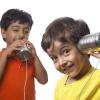- List examples of ways you can support children’s communication and language development.
- Explore resources that provide information on supporting the language and communication development of all children in your classroom.
- Discuss how you can support the language and communication skills of children with special learning needs in your classroom.
Learn
"The basic building block of good communications is the feeling that every human being is unique and of value." - Unknown
Know
Preschoolers in your care need daily opportunities to participate in activities that help them learn new skills and practice existing ones in fun, stimulating, and supportive environments. As you learned in Lesson 1, effective communication skills are integral to children’s self-expression, to their development of social relationships, and to their learning. In your daily work with preschool children, you should plan and embed opportunities for teaching language and communication skills throughout the day. This is essential for promoting language and communication in young children.
Reflecting on Language and Communication in Preschool
Knowing that your environment contributes greatly to children’s learning, one of your starting points can be to reflect on the language and communication development of the children in your class. You can start with observations, communication with families, the developmental screening and assessment information you collect, and questions about each child’s development and the interests and discoveries they are making. For example:
- What is the nature of the child’s language? What type and length of sentences does he or she use? Does the child take multiple turns in a conversation?
- What languages is the child learning or speaking at home? To which language is the child most responsive?
- How does each child communicate that he or she is hungry, tired, bored, or ready for play?
- How does each child express their emotions?
- How does each child communicate with adults? Peers?
- How does the preschooler respond to books? Does he or she recognize basic concepts about print like holding books upright, turning pages, pointing to words and pictures?
- What types of books is each family reading to their preschooler?
- How are other areas of development being supported through books and reading?
- What writing experiences is the child having? Does the child try writing or scribbling letters? Does the child seem to understand that print has meaning?
By asking these questions, in collaboration with families, you have an opportunity to document and learn how each child develops language and communication skills. This process can help you and families gather information to support the planning for and development of responsive environments as preschoolers develop language skills and learn ever more complex ways to communicate their needs and wants.
Creating Natural Opportunities for Language
You have amazing opportunities to spark language and conversations in your preschool classroom. There are countless times throughout the day for you to encourage children to talk, read, and write. The first step in creating natural opportunities for communication is getting to know the children in your classroom and how they communicate or use language. The questions in the previous section will help you understand the different ways children communicate in your classroom.
After you have gathered information about how children communicate in your classroom, you should use it to make decisions about experiences you want to provide or strategies you want to use. Think about the daily routines and experiences or activities taking place in your classroom: what opportunities for communication are natural in those routines? For example, during snack time, you can ask children questions about their favorite snacks, ask what they like to eat at home, or engage them in conversations about colors, textures, or tastes of different snacks. You may also provide them with choices of food items, or arrange the environment in ways that promote children’s communication. You can, for example, provide children with smaller portions of snack items to create opportunities for them to use language to ask for more if they want. You may also purposefully place some food items out of their reach so they can ask you, or peers for them.
With careful planning, you can adapt and embed communication strategies into multiple experiences and routines in your preschool classroom. As children in your classroom are learning new skills, you will be continuously assessing their progress and adapting your strategies to continue to promote their development.
Providing a Language- and Communication-Rich Classroom Environment
Language- and communication- rich preschool classroom environments are intentionally designed to promote children’s language development through high-quality verbal interactions and exposure to language and a variety of print. Consider the following components of language- and communication-rich classroom environments:
Responsive adults: Respond to children’s language and build on their ideas and interests. It’s more important to focus on their ideas than on their grammar. If children use words incorrectly, simply model appropriate language and continue the conversation. For example, if Julia says, “My grandma gived me a book,” you could simply respond, “It’s so nice your grandma gave you a book. What’s it about?”
Frequent use of developmentally appropriate models: Children need to hear, listen to, and use language throughout the day. By using language that is at or slightly above the child’s current level, you can promote development. Being aware of the level of complexity of the language you use is one of the most important things to remember when communicating with young children. For example, with young 3-year-olds, you might use three- to four-word sentences with simple vocabulary words to ensure that children can understand and participate in the conversation. As children get older, you can use more words in each sentence and introduce new vocabulary words. This means that you use language throughout your day and encourage children to use language too.
Intentionality: Intentional teachers purposefully select and use appropriate language models and literacy with children. This means that during your planning, and considering children’s needs, you make decisions about words or sounds to use, new vocabulary to introduce, how to describe events, materials, or feelings, or how to adapt activities and experiences to address the special learning needs of children in your classroom.
Environmental print and books: Remember to provide multiple opportunities for children to read and see books and print around the classroom. This includes reading frequently to children, labeling classroom spaces or objects, labeling in different languages that represent the backgrounds of children in your classroom, having lots of books readily accessible to children all around the classroom, rotating books and materials based on children’s interests and experiences, creating an inviting area in your classroom where children can read quietly or with other children, providing activities that involve drawing and writing, and embedding experiences that involve playing with sounds, words, and letters in activities and routines.
Family involvement: Acknowledging that families are children’s first and most significant teachers is critical for your work in preschool. As highlighted in Lesson Three, involving families in children’s communication development is essential for learning. This means developing relationships with the families of children in your classroom. In Lesson Three, you can find a list of practices that help foster relationships with families.
Repetition: Using repetition means that you provide children with frequent language models, particularly when teaching new vocabulary words. In language-rich classrooms, repetition happens throughout the day. Teachers use the same words in fun ways (i.e., through songs or games) to describe daily routines or events, label feelings or materials, etc. Repetition ensures children have varied and multiple opportunities to learn new words or new uses of words. Repetition is also important when teaching new concepts. Children need time and practice to learn new skills such as letter recognition, rhyming, counting and sorting, or print awareness. To master a skill, children need to experience the concept multiple times across multiple domains. Refer to the Learn section of this lesson for examples of instructional techniques you can use in your classroom to promote children’s communication and skill development.
Supporting Communication for All Children
Some preschoolers in your class may have conditions that affect their language and communication development, including developmental delays, autism, neurological and perceptual disorders, or vision, hearing, speech, or language impairments. Children with Individualized Education Programs (IEP) have a specific plan to help them meet their personal goals, and very often these children will need changes or adaptations to daily routines, the classroom environment, and curriculum.
Below is additional information to consider as you continue to plan for responsive and engaging interactions, environments and experiences that support the preschoolers in your class.
Use different ways to communicate information with children. For example, visuals like picture schedules or photos showing steps of handwashing provide children with a sense of predictability, and they provide opportunities for interactions with print.
Other children may need different supports. For children with hearing impairments, you may have to adjust the speed or sound of your voice, speaking more clearly or at a slower pace. You may also have to check more often to see if children understood what you said. Children with visual impairments may use Braille, large print, or big books. Other children may require the use of assistive technology. This may include equipment such as communication devices that enable them to explore their surroundings and interact with others. As you have been reading throughout this course, it is critical that you get to know the children in your classroom to be able to support their successful participation in your program experiences. Make sure all children and families feel welcome and involved. The Kids Included Together (KIT) program can be a valuable resource for ideas. You can also consider Building Blocks and Kara’s Kit. These resources from the Council for Exceptional Children Division for Early Childhood provide practical, real world ways to help children succeed in their environments. See the Resources and Reference list for information about these materials.
Keep in mind that children who have difficulties communicating do not necessarily have disabilities or special learning needs. You may need to make accommodations or modifications depending on children’s skills and experiences and what is developmentally appropriate.
Meaningful Book-Reading and Story-Telling Practices in Preschool
Reading books and telling stories are important ways to support young children’s communication and language skills. Book-reading and story-telling experiences promote a variety of skills in young children including:
- Learning new vocabulary words.
- Developing knowledge of print
- Listening to and practicing communication skills (receptive and expressive communication).
- Understanding the elements of a story or a plot.
- Phonological awareness (recognizing the sounds of language and how language is structured).
- Relationship building, particularly as children are encouraged to read in small groups.
- Enjoyment about learning and opportunities for personal expression.
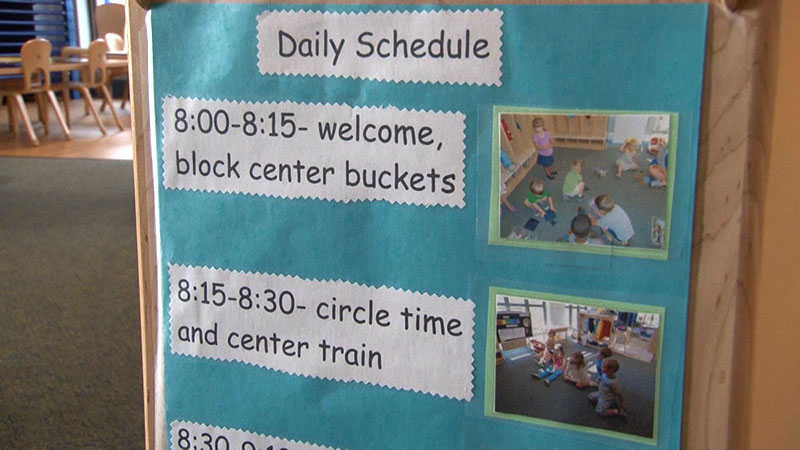
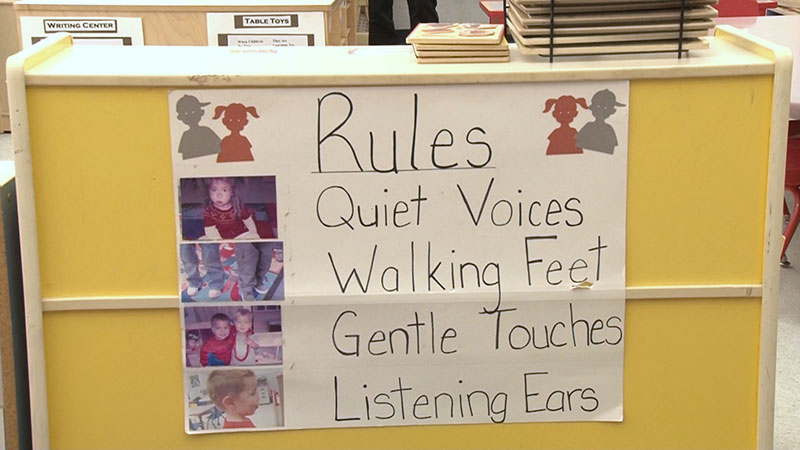
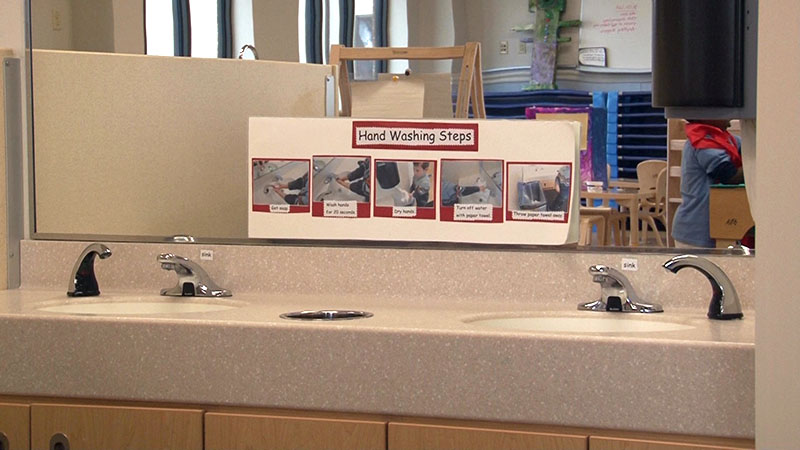
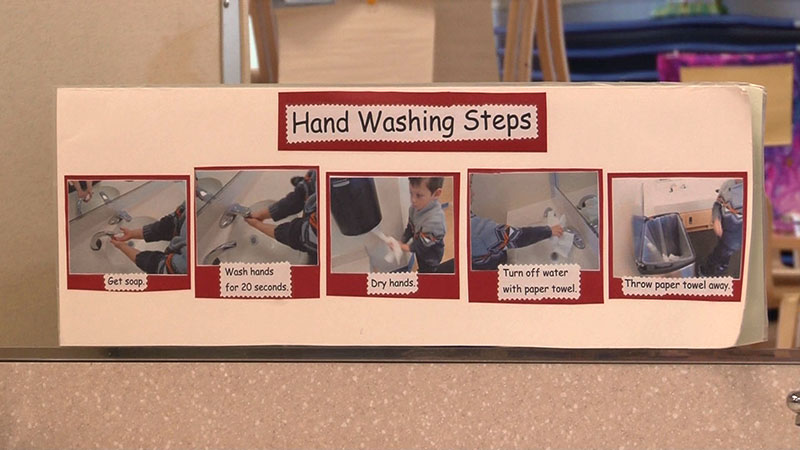
Consider the following when selecting and using books in your preschool classroom:
- Select books that highlight a variety of backgrounds, languages, abilities, family structures, and life experiences. Children need to be able to see themselves and their families in these books!
- Create an inviting book area where children can read independently or with other children.
- Incorporate books in the different interest areas in your classroom.
- Provide a variety of fiction and nonfiction books and reading materials.
- Read daily to children.
- Invite family members to come to your classroom and read books with the children.
- Rotate books based on child interests and activities.
- Involve children in selecting books. Give them choices and include their preferences.
- Use book reading as an opportunity to talk about social skills.
- Throughout the day, ask children questions about the story.
- Encourage children to write their own stories!
Consider the following strategies and adaptations to address the needs of children with special learning needs or children who are dual language learners during book-reading:
- Use visual props, large pictures, or other materials for children who are learning to listen and engage.
- Allow children to bring a favorite toy or stuffed animal to story time to help them sit and attend.
- For children who are learning to understand language and listen to stories, give them a copy of the book to hold.
- Have children take turns turning the book pages.
- Have children who are learning to engage in book reading sit next to an adult or a more competent peer.
- Give children frequent praise and encouragement for sitting and listening.
- Read the same book several days in a row and ask children to help you finish telling the story or fill in words they know.
- Speak clearly and slowly for children who have hearing impairments or who are dual language learners. Check for understanding often.
- Use Braille, large print, or big books for children who have visual impairments.
- Have children with autism or language delays repeat words or phrases.
- Translate familiar stories into children’s primary language for dual language learners.
- Send translated books and stories home with children.
- Borrow books from your local community or school library in children’s primary language.
- Invite fluent speakers of a child’s primary language to come to your classroom and read with the children.
Developing Language Through Media Literacy
The use of digital technology and non-screen media is quickly becoming an important tool with which we form our personal identities, build relationships, and express our values. Media literacy encompasses all media, including print and digital media technologies and is focused on helping young children understand the role of media and preparing them to use and create media in healthy ways. Like traditional forms of literacy, media literacy helps children develop new skills and attitudes, expand their creative thinking, and become effective communicators in today’s world. Preschoolers are frequent media users and teachers are incorporating digital media for educational purposes in the classroom more often. The Erikson Institue: Technology in Early Childhood Center offers these tips for adults to support preschooler’s media literacy skills:
- Provide facilitation and guidance when preschoolers use media
- Help children become aware of what media content makes them happy, sad, angry, frustrated, and scared
- Help children differentiate between reality and fantasy when engaging with media
- Use media to document and follow children’s interests and curiosities
- Honor children’s requests and choice to read books or engage with the same digital media repeatedly so that they can process the content and have agency over their own learning
- Help children learn about media including that it is constructed by someone with an intentional purpose. For example, sharing the name of the author or illustrator of a book before reading
- Guide children in accessing and making media selections
- Allow preschoolers to explore and question the media they are using
Consider the following actions to promote media literacy skills, knowledge, and habits in young children (Rogow, 2022):
Media Literacy Action | Experience Example |
|---|---|
| Access: You can support children's ability to locate and use media by... | Discussing common symbols from the media and their meanings (ex: a magnifying glass means “search”) |
| Comprehend: You can help children understand basic media messages by... | Making book selections based on the information on the cover (title, author, illustration, summary) |
| Communicate & Create: You can encourage children to express themselves using multiple layers of media by… | Inviting guest speakers via video conference |
| Engage & Explore: You can influence children to use media for purpose and enjoyment by… | Using old technology such as keyboards or digital cameras in dramatic play areas |
| Evaluate: You can teach children to ask if media is the right tool for a task by… | Discussing book preference and choices with children |
| Inquire: You can demonstrate for children how to use questions to analyze media messages by… | Sharing personal observations and setting aside time during activities for children to ask questions |
Communication and language development at all stages is a complex process and involves other areas of development, such as cognitive skills, and is enhanced by input from the environment (family, caregivers, peers, experiences, activities, etc.). Communication and language help us think, learn, problem-solve, remember and understand what we experience.
See
Communication Every Day All Day!
Book-reading and Story-telling Experiences
Do
Communication- and language-rich environments are characterized by intentional and frequent use of developmentally appropriate spoken and written language by children and adults. In your daily interactions with children in preschool consider the following:
- Be responsive to children’s communication attempts and build and extend on what children are saying.
- Provide frequent, developmentally appropriate language models throughout daily activities and routines.
- Follow children’s cues and preferences.
- Include new words in conversations.
- Embed language games, songs, and rhymes into daily routines.
- Ask children questions about their feelings, actions, interests, or life happenings.
- Read to children frequently. When selecting books and other printed materials, make sure they represent a variety of backgrounds, languages, abilities, family structures, and life experiences. Children are more likely to engage in conversations when they see themselves and their families in these materials!
- Offer children opportunities to practice language and literacy skills in the different interest areas in your classroom! Books, magazines, maps, or other printed materials should be available in every interest area. Consider, for example, providing maps, cookbooks, or magazines in the block area for children to use while building or constructing or in the dramatic play area for children to engage in imaginative play.
- It is important to remember to give children turns to communicate. Oftentimes, adults talk and talk and forget to give children opportunities to communicate. Even though it may be hard to stop and wait for children to respond, it is essential to do that to promote communication and conversation skills!
Explore
Read the scenarios and answer the questions in the Communication Scenario activity. Think about the unique ways the children in your program are communicating and how you might respond as a teacher. Then, share and discuss your responses with a trainer, coach, or administrator.
Having a robust library of children’s books in the classroom environment and including many opportunities to read to young children supports their language and literacy development, as well as other areas of development. Staff working toward their CDA credential should use the CDA Children’s Book Bibliography activity to create a list of developmentally appropriate children’s books for your classroom.
It is important to offer learning experiences and activities that are appropriate, engaging and supportive of children’s learning and development across various developmental domains including cognitive, social-emotional, physical, language and literacy, and creative development. Staff working toward their CDA credential should use the CDA Language and Literacy Activity Plan to develop a language and literacy learning experience from your curriculum (or a new activity you plan on implementing).
Apply
What are you currently doing to promote the communication, language, and literacy development of children in your classroom? Complete the Language-Rich Preschool Environment Inventory and review your responses with your coach, trainer, or administrator. Review the Embedding Writing and Print into Daily Activities and Routines activity to learn ideas for incorporating writing and environmental print in your classroom.
Read the article Promoting Preschoolers’ Emergent Writing from the National Association for the Education of Young Children (NAEYC). Be sure to review the article’s “Stages of Emergent Writing” table, which clearly outlines the different stages of children’s writing. This information can be helpful when measuring and sharing children’s writing progress and development.
Demonstrate
Berk, L. E. (2013). Child development (9th ed.). Pearson Education Inc.
Byington, T. & Kim, Y. (2017). Promoting Preschoolers’ Emergent Writing. Young Children, 72(5), 74-82.
Chandler, L. K., Young, R. M., Nylander, D., Shields, L., Ash, J., Bauman, B., Summers, D. (2008). Promoting early literacy skills within daily activities and routines in preschool classrooms. Young Exceptional Children, 11(2), 2-16.
Cooper, P. J., & Simonds, C. (1999). Communication for the Classroom Teacher. Pearson Education Inc.
Copp, S. B., Cabell, S. Q., Gabas, C., Slik, D., & Todd, J. (2022). The Rising Star Scaffolding Guide: Supporting Young Children’s Early Spelling Skills. The Reading Teacher, 76(4). https://doi.org/10.1002/trtr.2156
Council for Exceptional Children: Division for Early Childhood. http://www.dec-sped.org/
Edwards, C. C., & Da Fonte, A. (2012). The 5-Point Plan: Fostering successful partnerships with families of students with disabilities. Teaching Exceptional Children, 44, 6-13.
Milbourne, S. A., & Campbell, P. H. (2007). CARA's kit: Creating adaptations for routines and activities. Child and Family Studies Research Programs, Thomas Jefferson University.
National Association for the Education of Young Children (2014). Principles of Effective Practice: Two Way Communication. https://www.naeyc.org/principles-effective-family-engagement
National Board for Professional Teaching Standards (2012). Early Childhood Generalist Standards for teachers of ages 3-8 (3rd ed.).
National Communication Association (2014). What is Communication? https://www.natcom.org/discipline/
Ramsey, R. D. (2009). How to Say the Right Thing Every Time: Communicating well with students, staff, parents, and the public. Corwin Press.
Rogow, F. (2022). Start with Wonder, Then Add Inquiry: Developing Young Children’s Media Literacy. The National Association for the Education of Young Children. https://www.naeyc.org/resources/pubs/tyc/winter2022/wonder-and-inquiry
Sandall, S.R. and Schwartz, I. (2002) Building Blocks for Teaching Preschoolers with Special Needs. Paul H. Brookes Publishing Co., 2002.
Trawick-Smith, J. W. (2014). Early Childhood Development: A Multicultural Perspective, (6th ed.). Pearson Education Inc.
Wright, T. S., Cabell, S. Q., Duke, N. K., & Souto-Manning, M. (2022). Literacy learning for infants, toddlers, and preschoolers: key practices for educators. (No Title).


